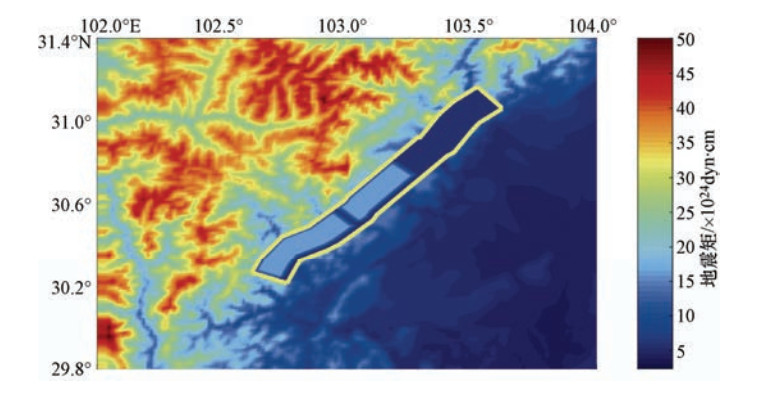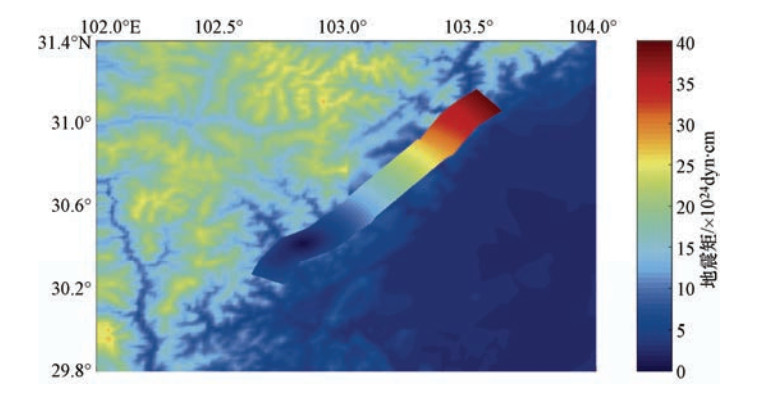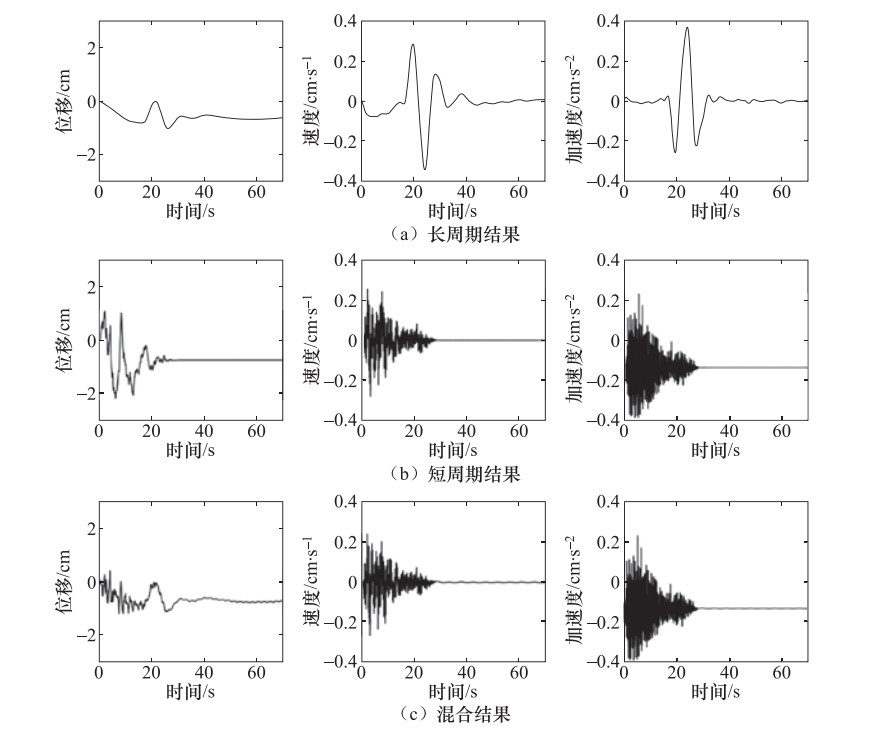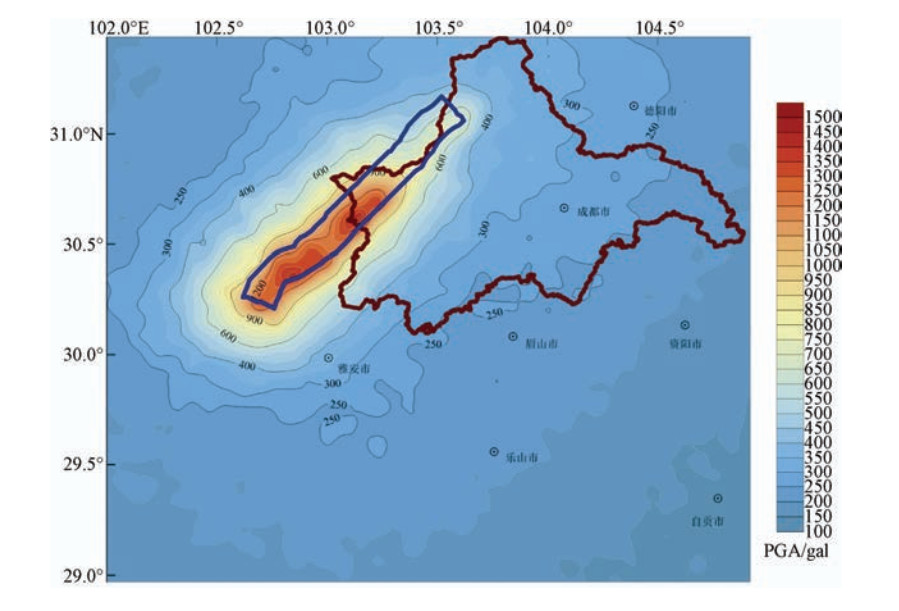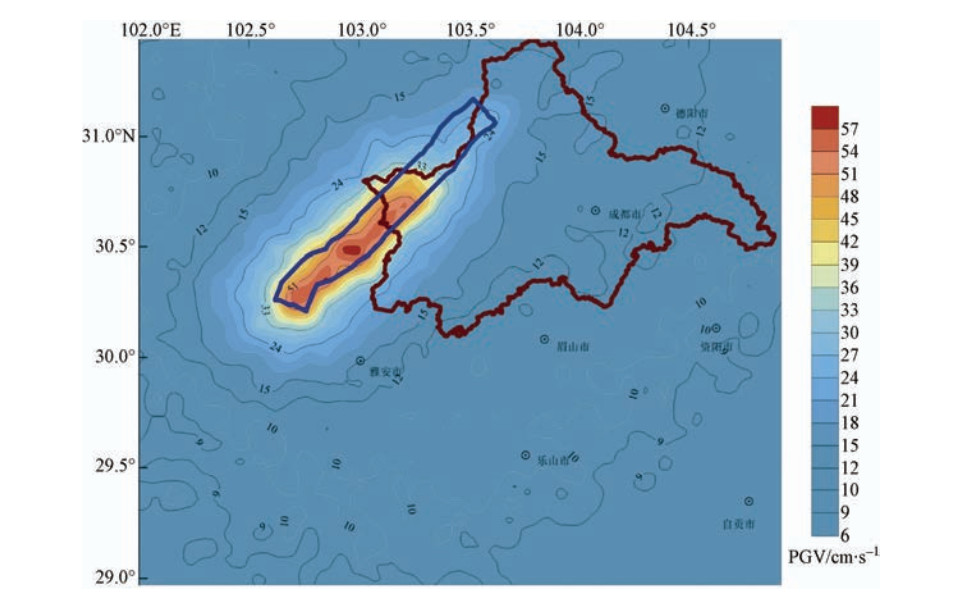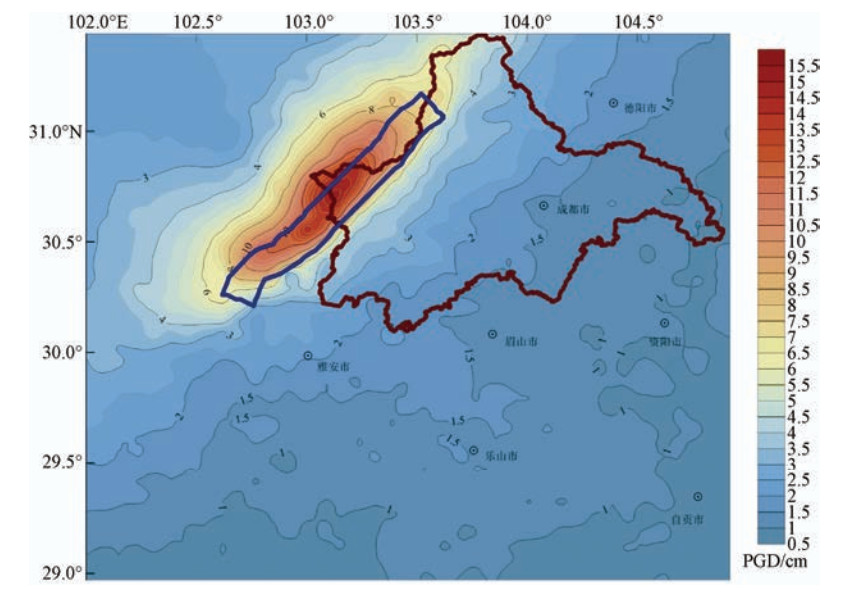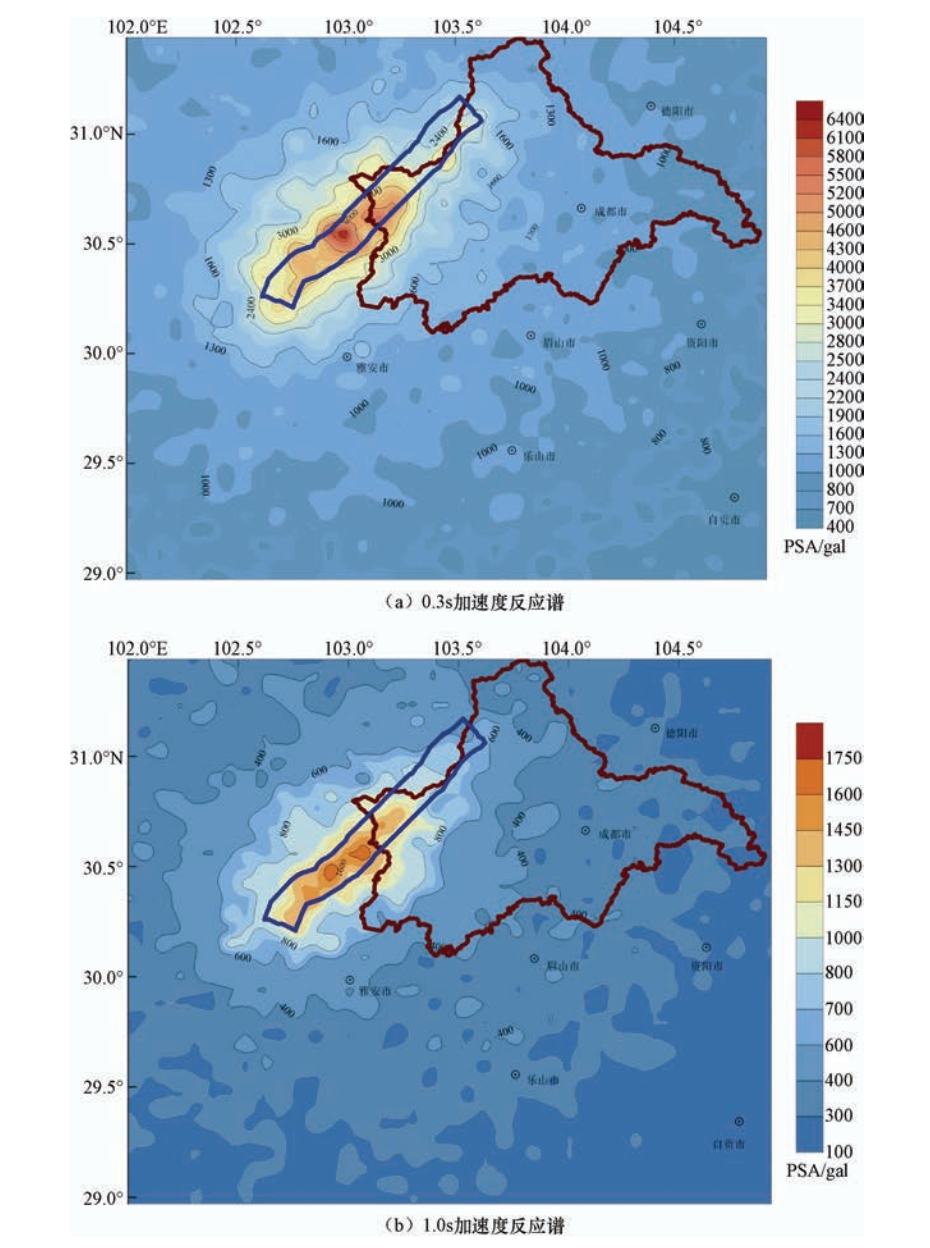The Simulated Ground Motion of Chengdu Fault in Broadband Frequency by the Hybrid Method
-
摘要: 首先,依据成都活断层探测的深、浅层地震勘探资料、钻井资料、地形资料,建立成都地区地下三维介质模型,并基于活断层确定的双石-大川断裂发生7.6级潜在地震的地震活动性探测结果,设定断层破裂震源模型,采用随机有限断层方法模拟短周期地震动、谱元法模拟长周期地震动,利用混合法通过频域合成技术获得了研究区域的宽频地震动。最后,讨论了合成结果的PGA、PGV、PGD以及0.3s和1.0s反应谱的分布特征,依据分布结果对成都市区进行了本次设定地震的地震动讨论。Abstract: Based on the seismic prospecting data of deep and shallow layers, drilling data and topographic data in Chengdu, a deep three-dimensional medium model of Chengdu is established. Then, based on the data of Shuangshi-Dachuan fault survey the rupture source model of MS 7.6 potential earthquake is set up. The stochastic finite fault method is used to simulate the short period ground motion and the spectral element method is used to simulate the long period ground motion. The broadband seismic motion is obtained by the frequency domain synthesis technology of two parts. Finally, the distribution characteristics of the synthetic PGA, PGV, PGD, 0.3s response spectrum and 1.0s response spectrum are given and discussed.
-
表 1 双石-大川断裂各段参数
Table 1. The fault parameters of Shuangshi-Dachuan fault
段号 端点纬度/°N 端点经度/°E 走向/° 倾向/° 长度/km 1 31.07 103.62 230 43.85 15 2 30.98 103.53 210 43.74 18 3 30.89 103.47 220 43.59 18 4 30.58 103.16 219 44.49 21 5 30.39 102.98 245 44.49 15 6 30.33 102.85 208 43.27 12 表 2 双石-大川断裂计算参数
Table 2. The computation parameters of Shuangshi-Dachuan fault
参数 设定值 断层长度/km 126 断层宽度/km 24 滑动角/° 90 长度方向分割量(NL) 42 宽度方向分割量(NW) 8 子源的长度/km 3 子源的宽度/km 3 震级 7.6 总面积/km2 3024 最大凹凸体面积/km2 483 次级凹凸体面积/km2 181 破裂速度/km·s-1 2.9 破裂形式 同心圆 震源时间/s 3.01 品子因子Q(f) 500f0.5 应力降/bar 90 -
Atkinson G. M., Assatourians K., Boore D. M., et al., 2009. A guide to differences between stochastic point-source and stochastic finite-fault simulations. Bulletin of the Seismological Society of America, 99 (6):3192-3201. doi: 10.1785/0120090058 Atkinson G. M., Goda K., Assatourians K., 2011. Comparison of nonlinear structural responses for accelerograms simulated from the stochastic finite-fault approach versus the hybrid broadband approach. Bulletin of the Seismological Society of America, 101 (6):2967-2980. doi: 10.1785/0120100308 Boore D. M., 1983. Stochastic simulation of high-frequency ground motions based on seismological models of the radiated spectra. Bulletin of the Seismological Society of America, 73 (6):1865-1894. Boore D. M., 2003. Simulation of ground motion using the stochastic method. Pure and Applied Geophysics, 160 (4):635-676. http://d.old.wanfangdata.com.cn/OAPaper/oai_doaj-articles_773ad1cbf1dcba3266bb060c1201c3cd Boore D. M., Thompson E. M., 2015. Revisions to some parameters used in stochastic-method simulations of ground motion. Bulletin of the Seismological Society of America, 105 (2A):1029-1041. doi: 10.1785/0120140281 Faccioli E., Maggio F., Paolucci R., et al., 1997. 2D and 3D elastic wave propagation by a pseudo-spectral domain decomposition method. Journal of Seismology, 1 (2):237-251. doi: 10.1023-A-1009758820546/ Frankel A., 2009. A constant stress-drop model for producing broadband synthetic seismograms:comparison with the Next Generation Attenuation relations. Bulletin of the Seismological Society of America, 99 (2A):664-680. doi: 10.1785/0120080079 Graves R. W., Pitarka A., 2004. Broadband time history simulation using a hybrid approach. In: Proceedings of the 13th World Conference Earthquake Engineering. Vancouver, Canada, 1-6 August. Graves R. W., Pitarka A., 2010. Broadband ground-motion simulation using a hybrid approach. Bulletin of the Seismological Society of America, 100 (5A):2095-2123. doi: 10.1785/0120100057 Komatitsch D., Vilotte J. P., 1998. The spectral element method:an efficient tool to simulate the seismic response of 2D and 3D geological structures. Bulletin of the Seismological Society of America, 88 (2):368-392. http://gji.oxfordjournals.org/cgi/ijlink?linkType=ABST&journalCode=ssabull&resid=88/2/368 Komatitsch D., Tromp J., 1999. Introduction to the spectral element method for three-dimensional seismic wave propagation. Geophysical Journal International, 139 (3):806-822. doi: 10.1046/j.1365-246x.1999.00967.x Motazedian D., Atkinson G. M., 2005. Stochastic finite-fault modeling based on a dynamic corner frequency. Bulletin of the Seismological Society of America, 95 (3):995-1010. doi: 10.1785/0120030207 Motazedian D., Moinfar A., 2006. Hybrid stochastic finite fault modeling of 2003, M 6.5, Bam earthquake (Iran). Journal of Seismology, 10 (1):91-103. doi: 10.1007/s10950-005-9003-x Pacor F., Cultrera G., Mendez A., et al., 2005. Finite fault modeling of strong ground motions using a hybrid deterministic-stochastic approach. Bulletin of the Seismological Society of America, 95 (1):225-240. doi: 10.1785/0120030163 Patera A. T., 1984. A spectral element method for fluid dynamics:laminar flow in a channel expansion. Journal of Computational Physics, 54 (3):468-488. doi: 10.1016/0021-9991(84)90128-1 Priolo E., Carcione J. M., Seriani G., 1994. Numerical simulation of interface waves by high-order spectral modeling techniques. The Journal of the Acoustical Society of America, 95 (2):681-693. doi: 10.1121/1.408428 Satyam N., Rao K. S., 2009. Estimation of peak ground acceleration for Delhi NCR using FINSIM, a finite fault simulation technique. International Journal of Geotechnics and Environment, 1 (2):147-159. Seriani G., Priolo E., Carcione J. M., et al., 1992. High-order spectral element method for elastic wave modeling. In:Proceedings of the 62th SEG Annual Meeting. New Orleans, Louisiana:Society of Expanded Abstracts, 1285-1288. Shahjouei A., Pezeshk S., 2015. Synthetic seismograms using a hybrid broadband ground-motion simulation approach:application to central and eastern united states. Bulletin of the Seismological Society of America, 105 (2A):686-705. doi: 10.1785/0120140219 Somerville P., Irikura K., Graves R., et al. 1999.Characterizing crustal earthquake slip models for the prediction of strong ground motion. Seismological Research Leteers, 70 (1):59-80. doi: 10.1785/gssrl.70.1.59 Zhou H., Jiang H., 2015. A new time-marching scheme that suppresses spurious oscillations in the dynamic rupture problem of the spectral element method:the weighted velocity Newmark scheme. Geophysical Journal International, 203 (2):927-942. doi: 10.1093/gji/ggv341 Zonno G., Carvalho A., Franceschina G., et al., 2005. Simulating earthquake scenarios using finite-fault model for the Metropolitan Area of Lisbon (MAL). In: Proceedings of the 250th Anniversary of the 1755 Lisbon Earthquake. Portugal, 1-4 November. Zonno G., Carvalho A., 2006. Modeling the 1980 Irpinia earthquake by stochastic simulation. Comparison of seismic scenarios using finite-fault approaches. In: Proceedings of the 1st European Conference on Earthquake Engineering and Seismology. Geneva, Switzerland, 3-8 September. -




 下载:
下载:
